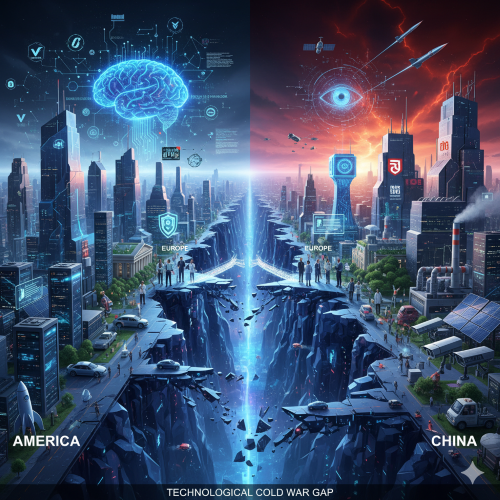Why is the U.S. still ahead in aerospace and defense technologies, while China is rapidly catching up with state-backed innovation?

The U.S. remains ahead in aerospace and defense technologies due to a deeply entrenched ecosystem of private-sector innovation, a unique military-industrial complex, and a culture of high-risk, high-reward R&D.
While China is rapidly catching up, its progress is largely a result of a state-led, top-down approach that leverages a massive industrial base and a "military-civil fusion" strategy to close the technological gap.
The American Advantage: Ecosystem of Innovation
The U.S.'s technological dominance is not merely a product of spending; it's a function of its unique innovation model, which is fundamentally different from China's. This model is characterized by three core pillars:
1. The Military-Industrial Complex
This term, coined by President Eisenhower, describes the symbiotic relationship between the U.S. government, its military, and private defense contractors like Lockheed Martin, Raytheon, and Northrop Grumman. The U.S. government, as the largest customer, provides these companies with massive contracts and funding for research and development. This ensures a steady revenue stream that allows them to invest in cutting-edge, long-term projects, from stealth aircraft to advanced missile systems. This system is a powerful driver of innovation and has produced a generation of unrivaled platforms.
2. Private-Sector Leadership and Venture Capital
Unlike China, a significant portion of U.S. defense innovation now comes from the private sector, particularly from Silicon Valley and a new class of defense tech startups. The U.S. government actively works with these companies, offering them a clear pathway to government contracts. Agencies like the Defense Innovation Unit (DIU) were created to bridge the gap between commercial technology and military needs. This is attracting a new generation of entrepreneurs and venture capitalists who are developing dual-use technologies in areas like artificial intelligence, data analytics, and autonomous systems. This model is highly agile and can integrate commercial-off-the-shelf technologies at a much faster pace than traditional government procurement.
3. High-Skilled Workforce and Research Base
The U.S. boasts a highly skilled workforce, particularly in engineering, R&D, and maintenance. The average income for a worker in the aerospace and defense industry is 56% above the national average, reflecting the specialized nature of these jobs. The country's top universities and national laboratories are also global leaders in fundamental research, providing a continuous pipeline of talent and breakthroughs that the defense industry can leverage. This is a crucial, though often overlooked, advantage that is difficult for other nations to replicate.
The Chinese Challenge: State-Driven Acceleration
China's rapid progress is a result of a coordinated, top-down strategy that aims to overcome the American advantage by leveraging the full power of the state.
1. Military-Civil Fusion (MCF)
China's most significant strategy is Military-Civil Fusion (MCF), which is designed to eliminate the barriers between its civilian research and commercial sectors and its military-industrial base. This allows the People's Liberation Army (PLA) to tap into China's vast and rapidly growing civilian tech sector for advancements in areas like AI, quantum computing, and robotics. Companies like Huawei and Alibaba are legally obligated to share their technology with the military, a concept that is foreign to the U.S. system.
2. Centralized, State-Directed Investment
Unlike the U.S. with its decentralized approach, the Chinese government directly funds and orchestrates its defense innovation. The state identifies strategic technologies—such as hypersonic missiles and carrier-killer anti-ship missiles—and then pours massive subsidies and resources into state-owned enterprises (SOEs) to ensure their development. This centralized approach allows for the rapid mobilization of resources and a unified national effort, which has enabled China to move from imitation to innovation and close the gap in key areas. For example, China is now a global leader in hypersonic weapons and has fielded them at scale, while the U.S. still faces significant challenges in testing and deployment.
3. Economies of Scale and Supply Chain Control
China's massive industrial base gives it a powerful advantage. It can produce military hardware at a scale and speed that the U.S. defense industrial base, which has consolidated over the past few decades, cannot easily match. China's dominance in rare earth minerals and other critical components also provides it with significant control over the global supply chain, giving it a chokehold on the raw materials needed for advanced military technologies. This is a point of vulnerability that the U.S. is now actively trying to address.
In conclusion, while the U.S. still holds a significant lead in overall aerospace and defense technology due to its robust ecosystem and culture of innovation, China's state-backed model is proving to be a highly effective accelerator. China's ability to leverage its civilian sector for military purposes and its willingness to invest at a scale and pace that the U.S. can only react to means that the technological gap is narrowing faster than many in the West expected. The U.S.'s challenge is to maintain its innovative edge while also addressing the supply chain vulnerabilities and the fragmented nature of its own industrial base.
- Questions and Answers
- Opinion
- Motivational and Inspiring Story
- Technology
- Live and Let live
- Focus
- Geopolitics
- Military-Arms/Equipment
- Безопасность
- Economy
- Beasts of Nations
- Machine Tools-The “Mother Industry”
- Art
- Causes
- Crafts
- Dance
- Drinks
- Film/Movie
- Fitness
- Food
- Игры
- Gardening
- Health
- Главная
- Literature
- Music
- Networking
- Другое
- Party
- Religion
- Shopping
- Sports
- Theater
- Health and Wellness
- News
- Culture

